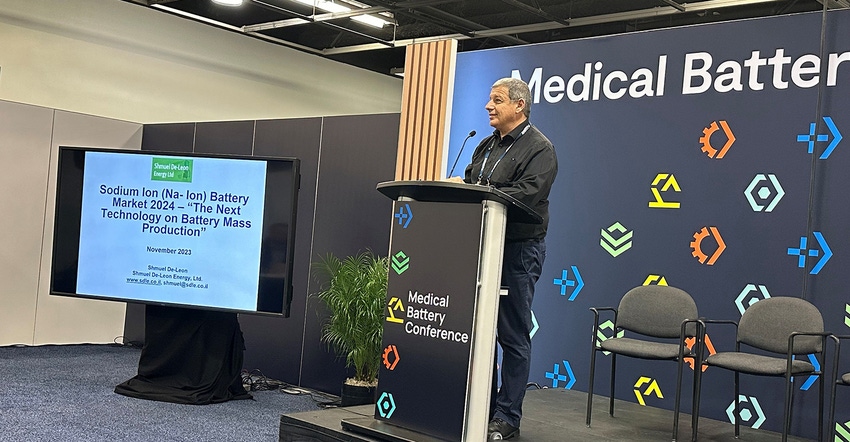Sodium-Ion Battery Market to Reach $5B by 2030
Explore the anticipated growth and potential of sodium-ion batteries as projected by Shmuel De-Leon. Gain insights into the evolving landscape of medical batteries.

At the Battery Medical Conference, Shmuel De-Leon, founder of Shmuel De-Leon Energy, Ltd.—a battery consulting company—gave a presentation titled “Sodium-ion battery market 2024,” where he talked about the evolving landscape of medical batteries, emphasizing the surge of sodium-ion batteries and accompanying challenges. He also stresses the emergence of new players in the sodium-ion battery sector, reshaping the conventional battery industry landscape.
De-Leon discussed the distinctive advantages of sodium-ion batteries over their lithium-ion counterparts. He explained that sodium-ion batteries boasted lower costs, heightened safety profiles, and a notable absence of lithium, cobalt, nickel, and copper materials. De-Leon said, “What are the advantages of sodium ions? First, no costs, of course, because we don't have the materials like lithium, nickel, and cobalt. We assume that in mass production, the cost of sodium-ion batteries will be between 60 to 70% of lithium iron phosphate (LFP) batteries.”
This absence contributed to cost reduction and alleviated concerns regarding material scarcity and environmental impact, thus positioning sodium-ion batteries as a sustainable alternative. Moreover, De-Leon highlighted the versatile application spectrum of sodium-ion batteries, spanning from electric vehicles, grid storage solutions, and construction machinery to medical devices. Their versatility, cost-effectiveness, and safety features made sodium-ion batteries a compelling choice across multiple sectors.
Of particular interest were De-Leon's predictions regarding the trajectory of the sodium-ion battery market. Based on his discussion with battery makers in China, he projected substantial growth, estimating a market size of $2.8B by 2028 and a staggering $5B by 2030. These predictions were grounded in the burgeoning demand for sodium-ion batteries, driven by their economic viability, safety attributes, and environmental considerations.
De-Leon's presentation also compared sodium-ion batteries with other battery technologies, elucidating their positioning vis-à-vis lithium-ion, lead-acid, and nickel metal hydride batteries. While acknowledging sodium-ion batteries' lower energy density than lithium-ion batteries, he emphasized their potential to capture market share in segments traditionally dominated by lead-acid and low-performance batteries.
He also mentioned Battery Management Systems (BMS), a critical component in battery technology. While discussing sodium-ion batteries, he noted that some companies claimed there was no need for BMS at all, suggesting that sodium-ion batteries might have inherent characteristics that alleviate the necessity for complex management systems. De-Leon said, “Sodium-ion batteries need a specific BMS, although some of the companies I talked with told me that there is no need for BMS at all.”
Addressing technical queries, De-Leon provided insights into the form factors preferred by sodium-ion battery manufacturers, attributing the prevalence of cylindrical cells to ease of mass production and mitigated thermal concerns. He also addressed concerns regarding energy density, thermal management, and the suitability of sodium-ion batteries for specialized applications like medical implants.
De-Leon elaborated on the role of sodium-ion batteries in medical devices, particularly emphasizing their suitability for backup power and hospital use. He pointed out that sodium-ion batteries offer a compelling solution for these applications due to their unique characteristics. He concluded, “Sodium-ion batteries present an appealing option for both backup power in hospitals and medical device applications due to their unique characteristics.”
Overall, De-Leon's presentation painted a picture of sodium-ion batteries as a disruptive force in the battery industry, poised to reshape the market landscape. His predictions underscored the growing significance of sodium-ion technology, fueled by its cost-effectiveness, safety features, and versatility besides its limitations (e.g., lower charge efficiency than lithium-ion batteries). As sodium-ion batteries continue to gain traction, their impact is poised to extend beyond conventional applications, ushering in a new era of sustainable energy storage solutions.
About the Author(s)
You May Also Like





